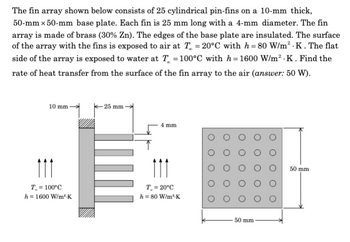
Elements Of Electromagnetics
7th Edition
ISBN: 9780190698614
Author: Sadiku, Matthew N. O.
Publisher: Oxford University Press
expand_more
expand_more
format_list_bulleted
Question

Transcribed Image Text:The fin array shown below consists of 25 cylindrical pin-fins on a 10-mm thick,
50-mm x 50-mm base plate. Each fin is 25 mm long with a 4-mm diameter. The fin
array is made of brass (30% Zn). The edges of the base plate are insulated. The surface
of the array with the fins is exposed to air at T = 20°C with h=80 W/m² .K . The flat
side of the array is exposed to water at T = 100°C with h=1600 W/m².K. Find the
rate of heat transfer from the surface of the fin array to the air (answer: 50 W).
10 mm-
111
T = 100°C
h = 1600 W/m².K
- 25 mm
4 mm
111
T. = 20°C
h = 80 W/m³-K
50 mm
50 mm
Expert Solution
This question has been solved!
Explore an expertly crafted, step-by-step solution for a thorough understanding of key concepts.
This is a popular solution
Trending nowThis is a popular solution!
Step by stepSolved in 2 steps with 2 images

Knowledge Booster
Learn more about
Need a deep-dive on the concept behind this application? Look no further. Learn more about this topic, mechanical-engineering and related others by exploring similar questions and additional content below.Similar questions
- You can neglect radiation at the bottom of the plate; the bottom side of the plate has water flowing underneath it. Often, when dealing with liquids (rather than gases), one can neglect radiation because heat transfer due to convection is so much larger (liquids tend to have higher convection coefficient values than gases).arrow_forwardPROBLEM 4: A black thermocouple is inside a chamber with black walls. If the air around the thermocouple is at 20°C, the walls are at 100-C, and the heat transfer coefficient between the thermocouple and the air is 75 W/m²K, what temperature will the thermocouple read?arrow_forwardThe Golden Gate Bridge in San Francisco has a main span of length 1.28 km, one of the longest in the world. Imagine that a steel wire with this length and a cross-sectional area of 4.10 x 106 m2 is laid in a straight line on the bridge deck with its ends attached to the towers of the bridge. On a summer day the temperature of the wire is 22.0°C. (a) When winter arrives, the towers stay the same distance apart and the bridge deck keeps the same shape as its expansion joints open. When the temperature drops to -10°C, what is the tension in the wire? (Take Young's modulus for steel to be 2.00 x 1011 N/m2, and the average linear expansion coefficient for steel to be 1.1 x 10-Soc-1.) (b) Permanent deformation occurs if the stress in the steel exceeds its elastic limit of 3.00 x 10° N/m2. At what temperature would the wire reach its elastic limit? (c) Explain how your answers to parts (a) and (b) would change if the Golden Gate Bridge were twice as long.arrow_forward
- A building window pane that is 1.68 m high and 1.12 m wide is separated from the ambient air by a storm window of the same height and width. The air space between the two windows is 0.06 m thick. If the building and storm windows are at 20 and -10°C, respectively, what is the rate of heat loss by free convection across the air space, in W? q = Warrow_forward= A processing plant is convectively heating a solid half-sphere of radius of 12 cm made of pure aluminum (k 237 W/m-K) by placing it on an insulated surface as shown in Fig. 1. It is exposed to hot exhaust gas at 300°C with a convection coefficient of 180 W/m².K. Is the lumped capacitance approximation valid? Figure 1: Half-spherearrow_forward
arrow_back_ios
arrow_forward_ios
Recommended textbooks for you
 Elements Of ElectromagneticsMechanical EngineeringISBN:9780190698614Author:Sadiku, Matthew N. O.Publisher:Oxford University Press
Elements Of ElectromagneticsMechanical EngineeringISBN:9780190698614Author:Sadiku, Matthew N. O.Publisher:Oxford University Press Mechanics of Materials (10th Edition)Mechanical EngineeringISBN:9780134319650Author:Russell C. HibbelerPublisher:PEARSON
Mechanics of Materials (10th Edition)Mechanical EngineeringISBN:9780134319650Author:Russell C. HibbelerPublisher:PEARSON Thermodynamics: An Engineering ApproachMechanical EngineeringISBN:9781259822674Author:Yunus A. Cengel Dr., Michael A. BolesPublisher:McGraw-Hill Education
Thermodynamics: An Engineering ApproachMechanical EngineeringISBN:9781259822674Author:Yunus A. Cengel Dr., Michael A. BolesPublisher:McGraw-Hill Education Control Systems EngineeringMechanical EngineeringISBN:9781118170519Author:Norman S. NisePublisher:WILEY
Control Systems EngineeringMechanical EngineeringISBN:9781118170519Author:Norman S. NisePublisher:WILEY Mechanics of Materials (MindTap Course List)Mechanical EngineeringISBN:9781337093347Author:Barry J. Goodno, James M. GerePublisher:Cengage Learning
Mechanics of Materials (MindTap Course List)Mechanical EngineeringISBN:9781337093347Author:Barry J. Goodno, James M. GerePublisher:Cengage Learning Engineering Mechanics: StaticsMechanical EngineeringISBN:9781118807330Author:James L. Meriam, L. G. Kraige, J. N. BoltonPublisher:WILEY
Engineering Mechanics: StaticsMechanical EngineeringISBN:9781118807330Author:James L. Meriam, L. G. Kraige, J. N. BoltonPublisher:WILEY

Elements Of Electromagnetics
Mechanical Engineering
ISBN:9780190698614
Author:Sadiku, Matthew N. O.
Publisher:Oxford University Press

Mechanics of Materials (10th Edition)
Mechanical Engineering
ISBN:9780134319650
Author:Russell C. Hibbeler
Publisher:PEARSON

Thermodynamics: An Engineering Approach
Mechanical Engineering
ISBN:9781259822674
Author:Yunus A. Cengel Dr., Michael A. Boles
Publisher:McGraw-Hill Education

Control Systems Engineering
Mechanical Engineering
ISBN:9781118170519
Author:Norman S. Nise
Publisher:WILEY

Mechanics of Materials (MindTap Course List)
Mechanical Engineering
ISBN:9781337093347
Author:Barry J. Goodno, James M. Gere
Publisher:Cengage Learning

Engineering Mechanics: Statics
Mechanical Engineering
ISBN:9781118807330
Author:James L. Meriam, L. G. Kraige, J. N. Bolton
Publisher:WILEY